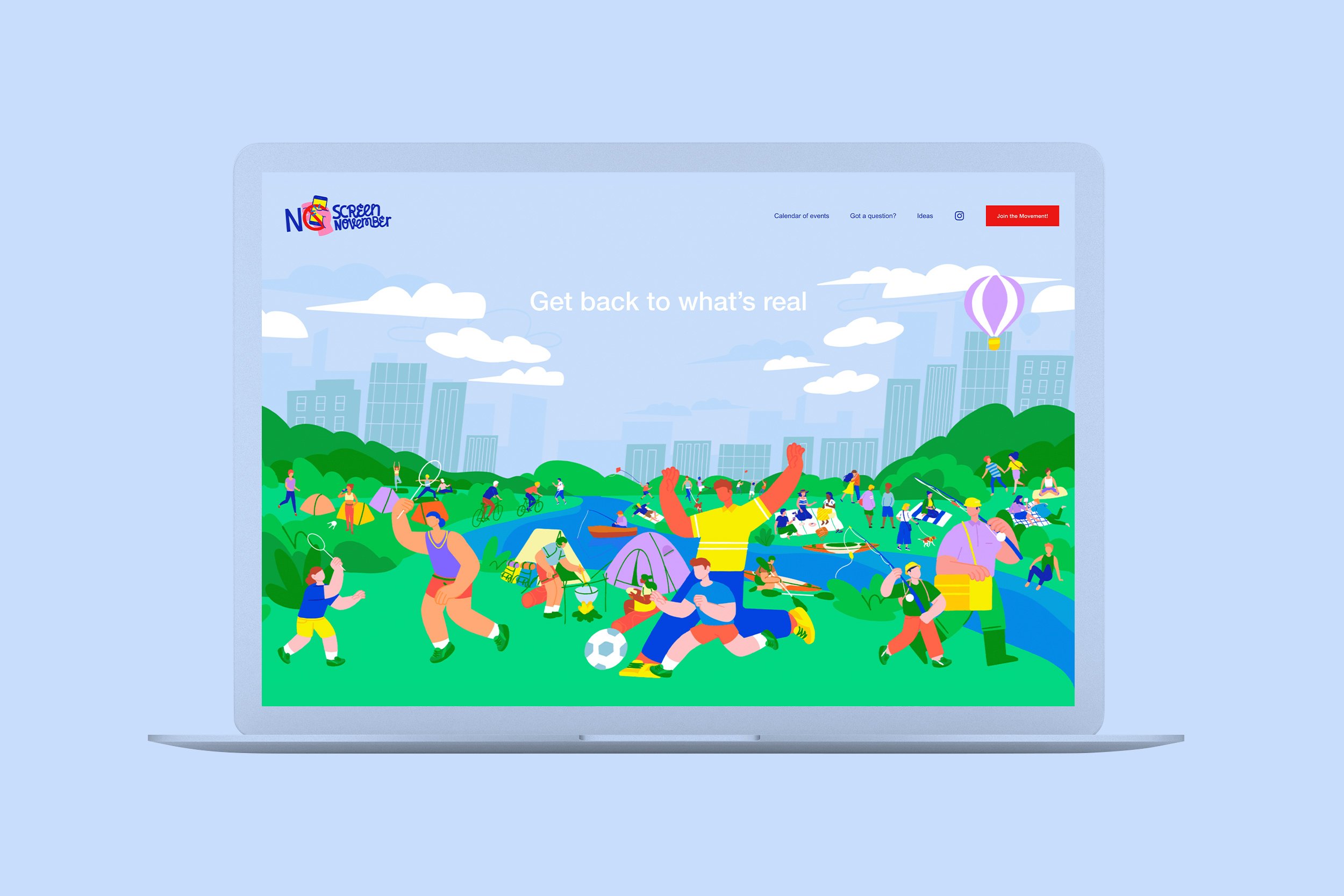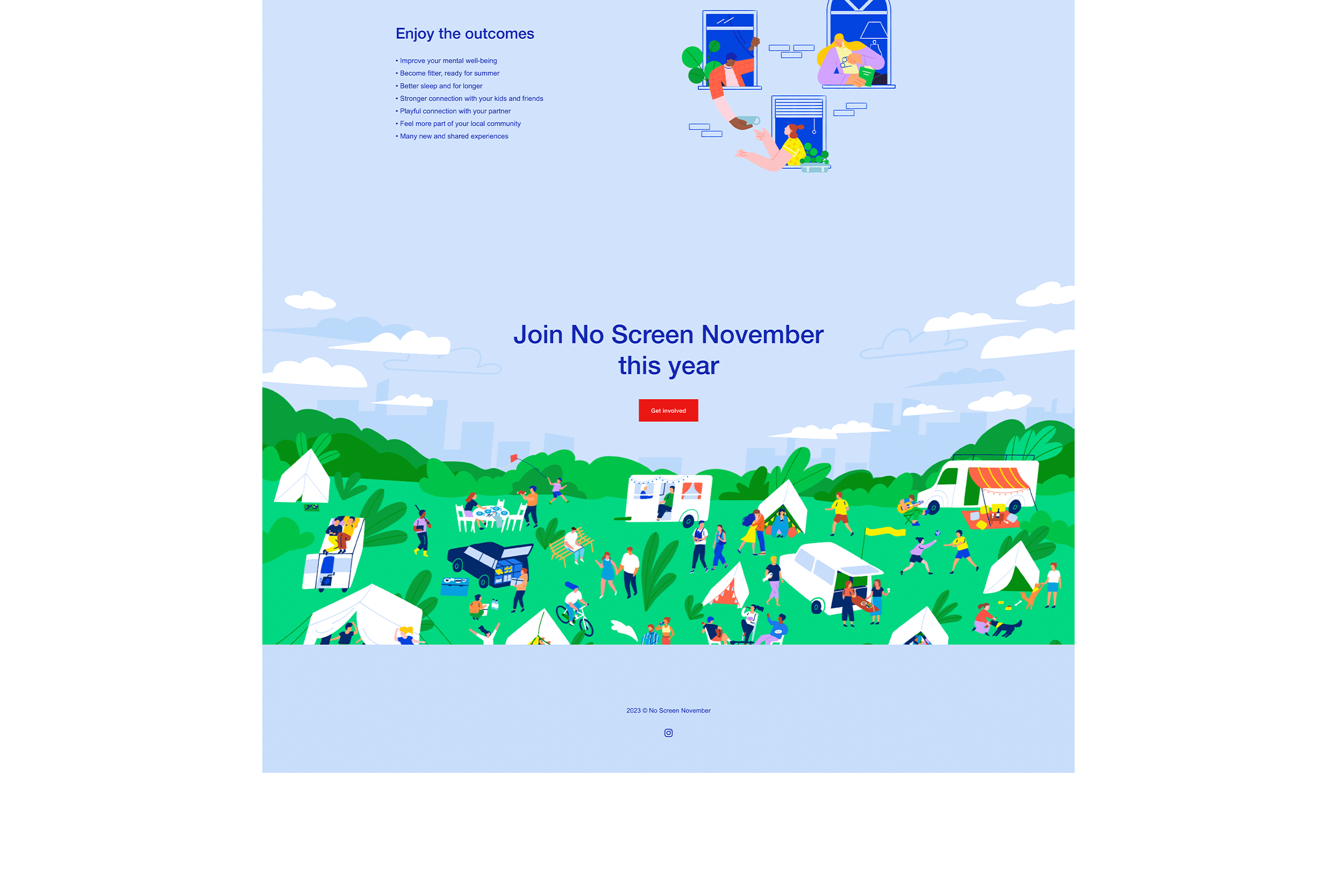
No Screen November:
Movement Campaign
Brief • In today's fast-paced, tech-driven world, families are increasingly distracted by screens, whether it's smartphones, tablets, computers, or TVs. While technology offers many benefits, excessive screen time is linked to issues like weakened family bonds, poor mental health, reduced physical activity, and disrupted sleep patterns. The No Screen November Movement is designed to help families take back their time, prioritising meaningful interactions and experiences that don’t involve screens.
Create a campaign and campaign styles to promote the movement is about encouraging families to reconnect with each other through activities that promote face-to-face interaction, physical play, and quality time. By introducing the No Screen November, families will be encouraged to set aside digital distractions for a month dedicated to changing bad habits to making better choices.
Target Audience:
Australian families with children (parents, guardians, and children of all ages)
Goal:
Raise awareness about the impact of digital distractions on family life and encourage families to reconnect by reducing screen time.
Campaign Duration:
10 weeks, 6 weeks leading up to November, then through that month.
Deliverables:
Campaign Logo & Visual Identity
• A friendly logo that conveys the idea of “disconnecting” in a playful, inviting way.
• Use warm, natural colours (greens, blues, yellows) to evoke feelings of connection, calm, and wellness.
Social Media Content & Engagement
• Posts, infographics, and animations that highlight the benefits of screen-free time.
• Instagram & Facebook Posts: Vibrant, shareable content with activity ideas, motivational quotes, and real family stories.
• Challenges & Hashtags: Families are encouraged to join for the month or weekly challenges (e.g., #ScreenFreeDays or #NoScreenNovember) and post about their experiences.
Website/Hub:
• A central online hub where families can find resources, join the movement, and share their own stories.
• Guidance that offers practical tips for reducing screen time.
• "Family Screen-Free Week" challenge kit with suggestions for each day (e.g., "Tech-free Tuesday" with outdoor games, "Family Movie Night" with a non-screen-based activity like cooking together, etc.).
Offline Promotion:
• Promote the movement at local community events aimed at families.
• Partnerships with government initiatives, festivals and local events to promote the campaign in family-friendly spaces.
Key Message:
“Get back to what’s real.”
The tone is positive, encouraging, and non-judgmental, focusing on the benefits of spending time together rather than demonising technology.
Ad Campaign • Social Media Advertising Touchpoints
To drive engagement and participation in the No Screen November Movement, we focused on key social media touchpoints that are interactive, real, relatable, and inspiring:
Hashtags & Challenges
#NoScreenNovember – The main campaign hashtag for users to share their screen-free moments.
#ScreenFreeWeekend – Encourage participants to go screen-free for weekends and share their experiences.
#GetBackToReal – Promote offline activities and connection.
#BeRealWithYourself – Encourage participants to challenge themself to complete a passion project or train and compete in a sport event.
#FamilyTimeChallenge – Weekly family-based activities shared on social media.
Paid Ads (Instagram, Facebook, TikTok)
• Carousel & Video Ads – Highlight campaign benefits like better sleep, stronger family bonds, and more outdoor time. Use relatable images/videos of families enjoying offline activities.
• Story Ads – Quick, punchy visuals asking, “Will you go screen-free this weekend?” with countdowns and call-to-action.
• Target Audience: Families (ages 30-45) with kids 4-18, health-conscious individuals.
Influencer Collaborations
• Family & Wellness Influencers – Partner with influencers to share their screen-free experiences and encourage followers to join the movement.
• Micro-Influencers – Amplify the message with relatable content showcasing screen-free weekends.
User-Generated Content (UGC)
• Content Sharing – Encourage users to share their screen-free moments with the campaign hashtags. Feature the best posts on the brand’s socials.
Local Engagement & Events
• Offline Meet-Ups – Promote local offline events (e.g., park picnics) via socials.
• Geo-Targeted Ads – Highlight local events or activities related to the campaign.
• Weekly Themes – Focus on different activities available each week in different states (e.g., music festivals, outdoor play, cooking together) and ask followers to share their experiences.
Interactive Social Media Posts
• Polls & Quizzes – Engage users with questions like “Could you go a weekend without screens?”
• Behind-the-Scenes – Share real-life moments of families and influencers going offline.
Social Media Takeovers & Live Sessions
• Takeovers – Influencers or families take over brand socials to share their screen-free journey
• Live Q&A – Host experts discussing screen time management and family connection.
Incentives
• Giveaways – Offer prizes like weekend fishing licenses, outdoor gear or family activity vouchers for users who share their screen-free experiences.
TikTok Campaign
#NoScreenChallenge – A viral challenge where users share how they spend a screen-free day or weekend.
These social media touchpoints will engage families and individuals in fun, relatable ways, helping spread the No Screen November Movement and create real-world connections.
Campaign Outcomes:
The No Screen November Movement provided a great opportunity for all they got involved the chance to take back control of their screen time and reconnect in meaningful ways – whether starting with a weekend, a fortnight, or committing to a full month. This campaign provides the support and tools to help reduce digital distractions and embrace real-world moments, just in time for the Australian Summer.
In 2023, No Screen November had 15 times more participants than in the previous 5 years combined, with all involved getting different outcomes:
• Better mental well-being by leaving behind the constant buzz of socials.
• Becoming fitter and more active, helping you feel ready for summer fun.
• Sleeping better and longer, with less blue light and more restful nights.
• Building stronger connections with your kids, friends, and family through real, shared experiences.
• Reignited spark with partners, enjoying those intimate, fun moments away from the screens.
• Feeling more connected to your local community, spending quality time with those around you.
• Having many new, shared experiences that will make lasting memories, far beyond the digital world.
This movement isn’t just about turning off screens – it’s about turning up the connection, energy, and well-being in your everyday life.







